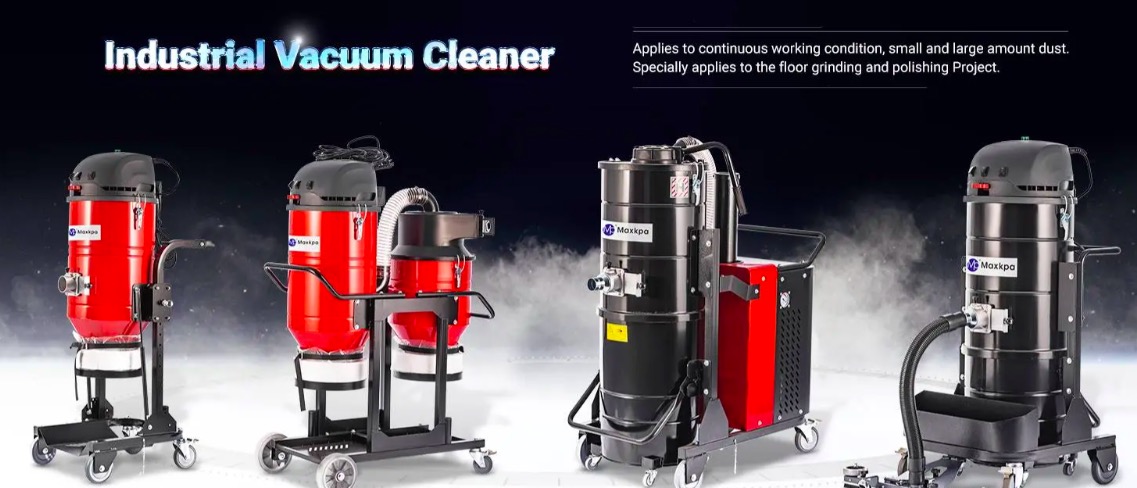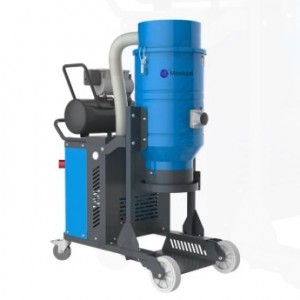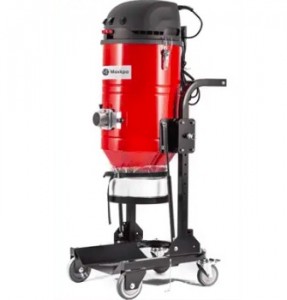When selecting the right industrial vacuum, one critical decision often gets overlooked: whether to choose a Three Phase or Single Phase model.
Yet this choice can significantly impact performance, efficiency, and long-term costs.
A Three Phase vacuum delivers robust, stable power—perfect for continuous, heavy-duty operations in industrial settings.
Meanwhile, Single Phase units offer flexibility and simplicity for lighter tasks in standard workshop environments.
Understanding these differences isn’t just technical—it’s strategic.
Making the right call means maximizing uptime, reducing maintenance, and getting the most value out of your equipment.
Understanding those differences early can save you time, energy, and serious costs. Keep reading to see which solution fits your workflow best.
Why Industrial Vacuum Selection Matters?
Choosing the right industrial vacuum cleaner is far more than a casual purchase; it's a critical strategic decision that significantly impacts a facility's safety, efficiency, productivity, and long-term operational costs.
Unlike commercial or residential vacuums, industrial models are engineered to handle the unique, often demanding, conditions of industrial environments.
1.Ensuring Workplace Safety and Health
-Dust Control: Industrial processes often generate vast quantities of dust, including hazardous types like combustible dust, silica, or fine particles. The wrong vacuum can re-circulate these contaminants, leading to respiratory illnesses, allergic reactions, and even explosions (in the case of combustible dust). Proper industrial vacuums, especially those with HEPA or ULPA filtration and ATEX certifications (for explosive atmospheres), safely capture and contain these dangerous materials, protecting worker health and preventing catastrophic incidents.
-Compliance: Many industries are subject to strict regulations (e.g., OSHA, NFPA) regarding dust control and hazardous material handling. Selecting a compliant vacuum is essential to avoid hefty fines, legal liabilities, and ensure a safe working environment.
-Slip and Fall Prevention: Efficiently removing liquids, oils, and solid debris prevents slips, trips, and falls, a common cause of workplace injuries.
2.Optimizing Operational Efficiency and Productivity
-Powerful Performance: Industrial vacuums are designed with superior suction power (waterlift) and airflow (CFM) to quickly and effectively collect heavy, large volumes of materials – from metal shavings and coolants to fine powders and general debris. This reduces cleaning time, allowing employees to focus on core production tasks.
-Continuous Operation: Many industrial environments require constant cleaning to maintain production flow. Properly selected industrial vacuums (e.g., three-phase models) are built for continuous, heavy-duty operation without overheating, minimizing downtime.
-Reduced Downtime: Effective cleaning prevents dust and debris from accumulating on machinery, which can cause wear and tear, malfunctions, and costly breakdowns. A good vacuum system contributes to machinery longevity and consistent production.
-Material Recovery: In some industries, industrial vacuums can recover valuable spilled materials, reducing waste and contributing to cost savings.
3.Cost-Effectiveness and Longevity:
-Durability: Industrial vacuums are constructed with robust materials and components to withstand harsh conditions, impacts, and heavy use. Investing in a durable model reduces the need for frequent repairs or replacements, offering a lower total cost of ownership over time.
-Energy Efficiency: While powerful, many industrial vacuums are designed for optimal energy efficiency, especially when matched correctly to the application. This can lead to significant savings on electricity bills over continuous operation.
-Reduced Labor Costs: A highly efficient vacuum can clean larger areas faster and more thoroughly, reducing the labor hours dedicated to cleaning.

What is Three Phase Industrial Vacuum?
A Three Phase Industrial Vacuum is a heavy-duty cleaning system designed for demanding industrial environments that require continuous, high-performance operation. Powered by a 380V or higher three-phase electrical supply, this type of vacuum cleaner is built to handle large volumes of dust, debris, liquids, and hazardous materials over extended periods without overheating or losing suction power.
Three-phase vacuums are engineered for round-the-clock use in manufacturing plants, warehouses, and other high-intensity settings. They feature powerful motors (often up to 22 kW), advanced filtration systems, and durable components such as side-channel blowers and heavy-gauge steel construction. Many models also comply with international safety standards (e.g., NRTL, OSHA, ATEX), making them suitable for environments with combustible or fine dust.
In essence, a three-phase industrial vacuum provides superior suction, enhanced durability, and energy efficiency for heavy-duty applications, making it a critical asset for maintaining cleanliness, safety, and operational efficiency in industrial facilities.

What is Single Phase Industrial Vacuum?
A Single Phase Industrial Vacuum is a compact and versatile cleaning machine designed for light to medium-duty industrial and commercial applications. It operates on a standard 110V or 220V single-phase power supply, making it ideal for facilities that lack access to industrial-grade electrical systems.
These vacuums are typically lightweight, portable, and cost-efficient, often used in workshops, laboratories, warehouses, and small production areas. Despite their smaller size, many models are equipped with powerful suction capabilities, HEPA filtration, and the ability to handle both wet and dry materials. They are well-suited for intermittent use and can manage tasks such as dust removal, spill cleanup, and maintenance support without requiring specialized infrastructure.
In short, a single phase industrial vacuum offers a practical and energy-efficient solution for facilities needing reliable cleaning without the complexity of three-phase power, making it a popular choice for many small to mid-sized operations.

Key Differences Between Three Phase and Single Phase Industrial Vacuum
1.Power Supply Requirements: Three phase industrial vacuums operate on 380V or higher, making them suitable for large-scale facilities with industrial-grade power infrastructure. In contrast, single phase models connect easily to standard 110V or 220V outlets, making them ideal for smaller workshops or businesses without access to high-voltage supply.
2.Suction Power and Performance: For high-demand applications, three phase units deliver superior suction power and airflow to handle large debris and continuous workloads. Single phase vacuums are effective for lighter cleaning jobs, but they may not perform as efficiently under heavy-duty conditions.
3.Operational Duty Cycle: Three phase vacuums are designed for continuous 24/7 operation, offering consistent performance without overheating. Single phase options are more suitable for occasional or short-term use, as extended operation can lead to motor strain or overheating.
4.Size and Portability: Three phase systems are generally larger and heavier, often used as part of centralized installations in industrial settings. Meanwhile, single phase vacuums are compact and easy to move, offering greater flexibility in environments that require mobility.
5.Application Suitability: When it comes to specialized industries like metalworking or food production, three phase vacuums provide the durability and certifications needed for safe operation. Single phase units, on the other hand, are a practical solution for everyday cleaning tasks in labs, offices, or small-scale warehouses.
Advantages of Three Phase and Single Phase Industrial Vacuum
Advantages of Three Phase Industrial Vacuum
1. High Suction Power and Airflow
Three phase vacuums support larger motors (often up to 22 kW), delivering superior suction strength and airflow—ideal for collecting heavy dust, metal shavings, and liquids in demanding environments.
2. Continuous 24/7 Operation
Designed for uninterrupted use, these vacuums can operate continuously without overheating, making them perfect for production lines, large-scale manufacturing, and facility-wide cleanup.
3. Energy Efficiency for Heavy Loads
While total energy use may be higher, three phase vacuums perform more work per unit of energy. They remove larger volumes of debris faster, reducing runtime and overall energy costs in high-output applications.
4. Durability and Longevity
Engineered with industrial-grade components like side-channel blowers and heavy-duty steel housings, these machines withstand harsh conditions and offer longer service life with fewer breakdowns.
5. Lower Maintenance Requirements
Thanks to reduced motor strain and lower heat generation, three phase units typically require less maintenance over time, resulting in fewer disruptions and lower ownership costs.
Advantages of Single Phase Industrial Vacuum
1. Easy Power Accessibility
Single phase vacuums operate on standard 110V or 220V outlets, making them highly compatible with most commercial and light industrial facilities—no special wiring or electrical upgrades required.
2. Compact and Portable Design
Their lightweight construction and smaller footprint allow for easy transport between locations, ideal for tasks that require mobility across workstations, rooms, or multiple job sites.
3. Quick Installation and Setup
Plug-and-play functionality ensures minimal downtime—users can deploy the equipment without needing a licensed electrician or complex setup procedures.
4. Versatility Across Applications
Single phase units are well-suited for both wet and dry vacuuming tasks and often come equipped with HEPA filters, making them suitable for general maintenance in labs, workshops, warehouses, and retail environments.
Considerations for Choosing the Right Industrial Vacuum: Three Phase or Single Phase?
When selecting the right industrial vacuum, understanding the core performance differences between Three Phase and Single Phase models is essential for making an informed investment. Three Phase vacuums offer higher suction power, greater airflow, and continuous 24/7 operation, making them ideal for heavy-duty industrial environments. Their robust motors and durable construction allow them to handle large volumes of dust, debris, or hazardous material without compromising performance. In contrast, Single Phase vacuums are lighter, more portable, and cost-effective. They’re built for flexibility and are best suited for light to moderate cleaning tasks that don’t require sustained operation or industrial-grade power.
In terms of application fit, Three Phase vacuums should be prioritized in settings such as manufacturing plants, food processing facilities, metalworking environments, or any operation that involves combustible dust or continuous cleaning needs. These environments demand equipment that can handle high stress with minimal downtime, and three phase models are designed to meet those expectations.
Single Phase vacuums are the better choice for workshops, small warehouses, laboratories, or retail environments that require periodic cleaning without needing industrial-scale power. Their compatibility with standard electrical outlets and ease of mobility make them ideal for facilities that value flexibility and affordability.
For special scenarios—such as environments with limited electrical infrastructure or temporary job sites—Single Phase vacuums offer a plug-and-play solution with minimal setup. However, if the task involves flammable dust, metal particles, or ATEX compliance, a Three Phase vacuum with appropriate safety certifications should always be the preferred choice.
In summary, choosing between three-phase and single-phase industrial vacuums depends on your specific needs. Three-phase models are best for heavy-duty, continuous use in demanding environments, offering robust power and durability. Single-phase vacuums are more portable and cost-effective, suitable for lighter, intermittent tasks. Consider your facility's power supply, cleaning demands, and operational needs to make the right choice.
Post time: Jun-24-2025

